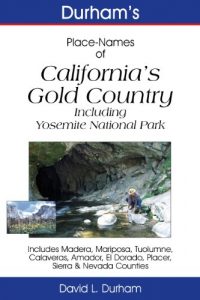• Above-ground graves resembling small, outdoor ovens furnished the name for the Mariposa County village of Hornitos. Hornitos is a Spanish word that means “little ovens.”
• In 1885, Alexander Kirkwood founded a hotel called Rattlesnake House in Tuolumne County. After his death, Mrs. Kirkwood remarried a fellow named William Priest. The hotel was generally called Priest’s Station after that and the locality is still known as Priest.
• The community of Groveland was once called Garotte because two Mexican thieves were hanged there in 1849. In the middle 1870s Benjamin Savory suggested the more genteel name of Groveland after his hometown in Massachusetts.
• In his 1880 book, Discovery of the Yosemite and the Indian War of 1851, Layfayette Houghton Bunnell claimed that, in 1851, he proposed the name “Yosemite” in the belief that this was the name by which the Indians who lived in present-day Yosemite Valley were known. Postal authorities established the Yo Semite post office in 1869 at Yosemite Village. Major H. C. Benson started Fort Yosemite in 1906 at the later site of Yosemite Lodge.
...just a taste from the scads of fascinating facts to be mined from Durham’s Place-Names of California’s Gold Country.
This gazetteer, one of fourteen volumes in the Durham’s Place-Names of California Series, is derived from California’s Geographic Names: A Gazetteer of Historic and Modern Names of the State, David L. Durham’s definitive gazetteer of California. Each volume of the series contains the complete body of entries contained in California’s Geographic Names for the counties covered.
Thousands of topographic features, such as ridges, peaks, canyons and valleys; water features, such as streams, lakes, waterfalls, and springs; and cultural features, such as cities, towns, crossroads and railroad sidings are included. Many entries include information about who named the feature, when and why, as well as alternate or obsolete names. A complete bibliography of sources is included.
Longitude and latitude are given for each feature, a boon to hikers wishing to use GPS devices to keep on track to their destinations.
Guaranteed to provide addictively entertaining browsing for residents of Madera, Mariposa, Tuolumne, Calaveras, Amador, El Dorado, Placer, Sierra and Nevada counties, this book will also delight:
• Tourists • Historians • Geographers • Students • Writers • Cartographers
• Genealogists • Hikers and outdoor folks of all kinds
• Great for browsing.
• Indispensable for research.
• Keep a copy on your mobile device to use on trips!
• In 1885, Alexander Kirkwood founded a hotel called Rattlesnake House in Tuolumne County. After his death, Mrs. Kirkwood remarried a fellow named William Priest. The hotel was generally called Priest’s Station after that and the locality is still known as Priest.
• The community of Groveland was once called Garotte because two Mexican thieves were hanged there in 1849. In the middle 1870s Benjamin Savory suggested the more genteel name of Groveland after his hometown in Massachusetts.
• In his 1880 book, Discovery of the Yosemite and the Indian War of 1851, Layfayette Houghton Bunnell claimed that, in 1851, he proposed the name “Yosemite” in the belief that this was the name by which the Indians who lived in present-day Yosemite Valley were known. Postal authorities established the Yo Semite post office in 1869 at Yosemite Village. Major H. C. Benson started Fort Yosemite in 1906 at the later site of Yosemite Lodge.
...just a taste from the scads of fascinating facts to be mined from Durham’s Place-Names of California’s Gold Country.
This gazetteer, one of fourteen volumes in the Durham’s Place-Names of California Series, is derived from California’s Geographic Names: A Gazetteer of Historic and Modern Names of the State, David L. Durham’s definitive gazetteer of California. Each volume of the series contains the complete body of entries contained in California’s Geographic Names for the counties covered.
Thousands of topographic features, such as ridges, peaks, canyons and valleys; water features, such as streams, lakes, waterfalls, and springs; and cultural features, such as cities, towns, crossroads and railroad sidings are included. Many entries include information about who named the feature, when and why, as well as alternate or obsolete names. A complete bibliography of sources is included.
Longitude and latitude are given for each feature, a boon to hikers wishing to use GPS devices to keep on track to their destinations.
Guaranteed to provide addictively entertaining browsing for residents of Madera, Mariposa, Tuolumne, Calaveras, Amador, El Dorado, Placer, Sierra and Nevada counties, this book will also delight:
• Tourists • Historians • Geographers • Students • Writers • Cartographers
• Genealogists • Hikers and outdoor folks of all kinds
• Great for browsing.
• Indispensable for research.
• Keep a copy on your mobile device to use on trips!



